Editor of this issue: Antanas Klimas
Copyright © 1986 LITUANUS Foundation, Inc.

|
LITUANUS
LITHUANIAN QUARTERLY JOURNAL OF ARTS AND SCIENCES
Volume 32, No. 2 - Summer 1986
Editor of this issue: Antanas Klimas ISSN 0024-5089
Copyright © 1986 LITUANUS Foundation, Inc. |

|
PORTRAIT OF MAGDALENA STANKŪNAS
SILVIA KUČĖNAS
Images of youthful days spent laboring on a farm in Lithuania before World War II have prevailed throughout the works of Magdalena Stankūnas, now living in Chicago.
Most recently noted for her woodcuts of faceless peasant women performing farm tasks, Stankūnas has also gained moderate fame for her oil paintings. A prolific artist, Stankūnas has created several hundred graphics and oil paintings in the last 20 years.
Her first 21 years on a farm in Suvalkija, between the cities of Marijampolė and Vilkaviškis, have seeded a lasting impression of colorfully dressed women rhythmically making bread, bleaching linen, harvesting grain or gathering hay in peaceful harmony.
"I'm not really sure how the idea of portraying working women developed in my art," said Stankūnas. "When I grew up, I was always close to nature and I remember fond images of women harmoniously working close to nature. Later these images came to me in waves and seemed to pull me toward recalling autumn days when women were harvesting flax. I would drive by on my bike after high school and just sit and watch these women singing and working, wearing colorful skirts. I think a person is formed during the youngest days. That's when you notice everything for the first time. I just started composing women at work. I did one, then another, then another."
When her family was forced to leave Lithuania after the Soviet occupation, Stankūnas fled to Germany, living in a displaced persons camp, and later went to England for 13 years. There she studied art at St. Martin's Academy in London. From England she would travel during vacations to various European countries, always drawn to the art museums. In Norway, she discovered the work of Edvard Munch, (1863-1944) a painter who in his later works turned to portraying nature, expressed vigorously and broadly in bright, rich colors.
Stankūnas was particularly impressed with one exhibit which displayed Munch's graphics alongside his oil paintings. She appreciated his versatility in transferring from one medium to another, an idea which she pursued for the rest of her life.
When she came to Chicago, she studied graphics with Viktoras Petravičius for one year. He acquainted her with mosaics, a method which widened her scope and would greatly improve her graphics.
"He taught me the techniques of printing, how to control the wood, how to cut it," said Stankūnas. "He explained how an artist must transfer what one feels, so that art would talk to a viewer. He said art must pulsate, not tremble."
In Chicago, she also studied at Bogan College, the Art Institute of Chicago and graduated from the Chicago Academy of Fine Arts. Her first exhibit in Chicago was in 1968. Since then, she has exhibited three more times in Chicago; and has shown her work in New York, Rochester, Cleveland, Toronto, Melbourne, Australia and Vilnius, Lithuania.
Donald J. Anderson, Chicago art critic, wrote about Stankūnas' work during the last Chicago exhibit in 1982 at Galerija. "The woodcut technique often utilizes a wide edging to a subject, enabling one form to be separate from the others for clarity and printing," wrote Anderson. "Stankūnas utilizes this edging as a broader band around the farm women. Here it is most fitting and in fact gives a halo Madonna-like treatment that elevates the farm worker to a special honor."
At this exhibit, Stankūnas displayed graphics and oils of peasant farm women working. Possibly inspired by Munch's exhibit, Stankūnas first made woodcuts and printed them. After they were printed, she colored them each by hand. Using the same themes displayed in the woodcuts, she then painted the scenes in oil. The result was like themes depicted in two mediums and shown within the same exhibit.
Victoria Matranga, Chicago art historian wrote, "Stankūnas recognizes the dignity of work, the hard labor and rhythmic beauty of farm tasks: sowing, weaving, laundering, baking, cutting and bleaching of flax, potato digging and mushroom gathering. The universal woman is central to the maintenance of family and farm production. This tender and nostalgic view of village life is reflected in the cycle of seasons of tasks."
Her portrayal of women without faces has raised attention by writers analyzing her art. "The tender, yet strangely unemotional, observation of women at work is sympathetic to the private lives of women," wrote Matranga. "These women are faceless, silent, secretive." Anderson mentioned, "The expert woodcuts are hand-colored, are pleasant to see and provide joy even though the faceless characters show no emotion." One of the best woodcuts, according to Anderson, is "Mushroom Pickers" which shows a boy and a girl in the distance who seem to be looking for mushrooms, even though their faces have no eyes. "Graceful patterns in this particular print use the curving direction of slender tree trunks to express, perhaps unknowingly, a feeling of youth and search," Anderson wrote.
"When you see people working in the distance, you don't clearly see their faces," explained Stankūnas. "When I watched the women work, 1 just saw them bending over, what the nature images were and the colors of the skirts. You can't see the fine details. I saw trees, green, red, another color. I wanted to show the general image of women working together, not portraits. I wanted to make the work as simple as possible, just depict the composition, the color and the farm theme."
She is drawn to continuously create new pieces as a means to return back to her beloved country. Having already visited Lithuania four times since her escape, Stankūnas is perhaps unconsciously pulled toward recapturing those lasting pre-World War II impressions. She achieves this through silent moments of yearning nostalgia and intense hours of cutting wood or brushing oil on canvas.
Recently back from another exhibit in Rochester April 18 to 20, 1986, Stankūnas said she works on her graphics and paintings to escape, to forget and surround herself in reverie. "When I work with wood I feel like I'm almost not here," said Stankūnas. "I forget everything. It seems as if I'm back in Lithuania among the people and the nature images. When I start cutting the wood, I begin to sing Lithuanian songs and I start to remember how it was then. I can't work without listening to music. It seems as if my life is somehow fuller when I'm working, as if I'm not missing anything."
While most equate the name Stankūnas with woodcuts, her passion for flowers has inspired her to search for exotic floral species in South America, Europe and the Far East. She has captured the beauty of azaleas, beloperones, and exacum-afcines in paintings. Her exhibit of flower arrangements was well attended in Chicago.
Recognized for her uncanny ability to portray simple images, Stankūnas' work shows that life's complex realities can be felt or perhaps even understood with a minimal amount of lines. A strong composer and deft user of color, Stankūnas has successfully achieved her ambition of depicting like images in various forms of art.
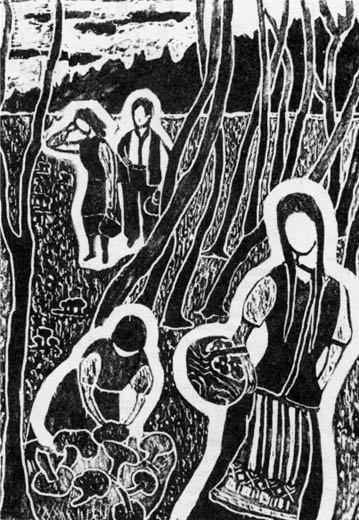
1. Mushroom Pickers. Linoleum.
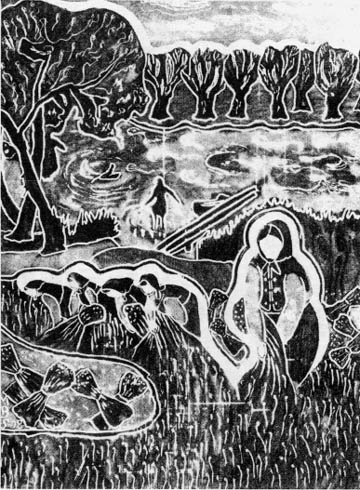
2. Flax Plucking
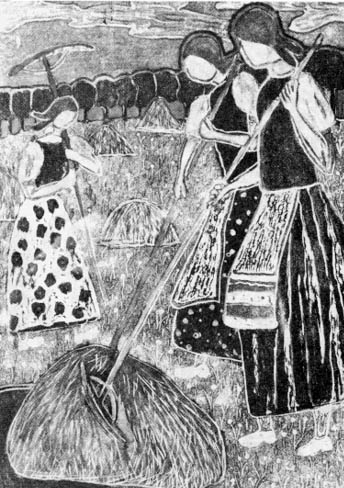
3. Hay Gatherers
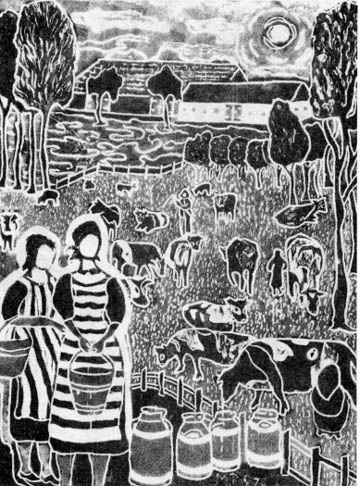
4. Milkmaids
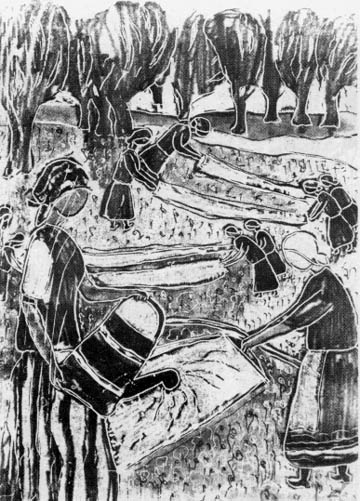
5. Linen Bleaching
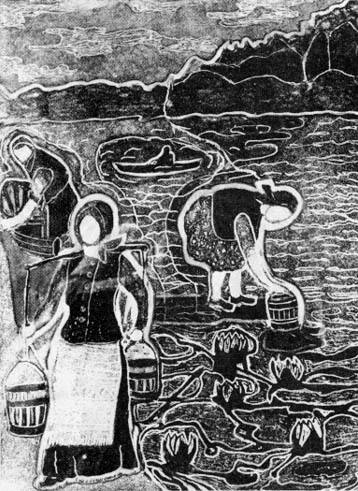
6. By (he Lake
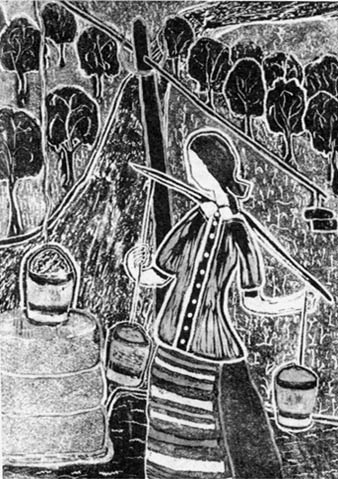
7. By the Well
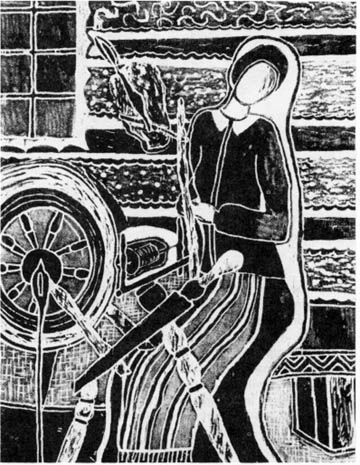
8. Spinning